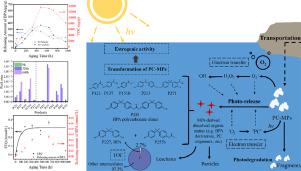Water Research ( IF 12.8 ) Pub Date : 2021-02-26 , DOI: 10.1016/j.watres.2021.116980 Yanqi Shi , Peng Liu , Xiaowei Wu , Huanhuan Shi , Hexinyue Huang , Hanyu Wang , Shixiang Gao

|
Bisphenol A polycarbonate (BPA-PC) is a kind of widely used engineering plastics. However, excessive usage causes the production of plastic wastes, following property changes of polymers and high risks of released chemicals during outdoor weathering. In this study, we systematically investigated the photoaging behavior of PC microplastics (MPs) in aquatic environment and evaluated the potential risk of released intermediates. Light irradiation along with mechanical abrasion facilitated the fragmentation of PC MPs and stimulated photooxidative modification during 640 h of ultraviolet (UV) exposure. Continuous degradation of the polymer was accompanied with dramatic decline of molecular weight. Also, BPA was released from irradiated PC MPs with a trend of an initial rapid increase followed by a decrease versus the irradiation time, and the maximum concentration of dropped BPA was detected up to 652.80 ± 72.89 μg/g (43.39% and 56.61% respectively in particles and leachates). However, the releasing amount of BPA in the leachate merely occupied 2.7% of the total organic carbon (TOC) leached out, suggesting that a great number of unknown organic products were produced other than BPA. Liquid chromatography-time-of-flight-mass spectrometry (LC-TOF-MS) analysis showed that these organic compounds forming MPs-derived dissolved organic matter (MPs DOM) were partly composed of 4,4’-dihydroxybenzophenone (DHB), p-hydroxybenzoic acid (p-HBA) and methyparaben (MeP), which would also contribute to the estrogenic activity. The degradation pathway of PC MPs was elaborated with the photolysis process of PC dimer and BPA, and the remarkable photoaging of PC MPs was mainly dominated by the generated reactive oxygen species (ROS). The findings of this study indicated that understanding the photoaging process of PC MPs was vital to evaluate their integral cumulative estrogenic activity in aquatic environment, and further highlighted the notable possible risks of plastic leachates to exposed biota.
中文翻译:

洞察断链和聚碳酸酯微塑料的光降解释放曲线
双酚A聚碳酸酯(BPA-PC)是一种广泛使用的工程塑料。但是,过量使用会导致塑料废物的产生,聚合物的性能变化以及室外风化过程中化学品释放的高风险。在这项研究中,我们系统地研究了PC微塑料(MPs)在水生环境中的光老化行为,并评估了释放中间体的潜在风险。光照射和机械磨损促进了PC MP的破碎,并在640 h的紫外线(UV)照射过程中促进了光氧化修饰。聚合物的连续降解伴随着分子量的急剧下降。此外,BPA也从受辐照的PC MP中释放出来,并且具有随辐照时间而开始迅速增加然后减少的趋势,检出的双酚A的最大浓度高达652.80±72.89μg/ g(颗粒和渗滤液中分别为43.39%和56.61%)。但是,渗滤液中BPA的释放量仅占渗出的总有机碳(TOC)的2.7%,这表明除BPA以外,还生产出许多未知的有机产物。液相色谱飞行时间质谱(LC-TOF-MS)分析表明,这些形成MPs衍生的溶解有机物(MPs DOM)的有机化合物部分由4,4'-二羟基二苯甲酮(DHB)组成,p -羟基苯甲酸(p-HBA)和对羟基苯甲酸甲酯(MeP),它们也有助于雌激素活性。PC二聚体和BPA的光解过程阐明了PC MPs的降解途径,PC MP的显着光老化主要是由产生的活性氧(ROS)决定的。这项研究的结果表明,了解PC MP的光老化过程对于评估其在水生环境中的整体累积雌激素活性至关重要,并进一步强调了塑料渗滤液对暴露的生物区系的显着风险。



























 京公网安备 11010802027423号
京公网安备 11010802027423号